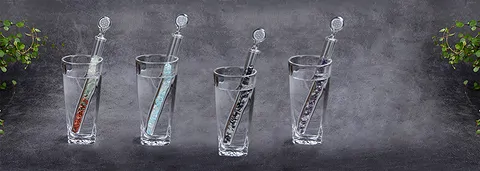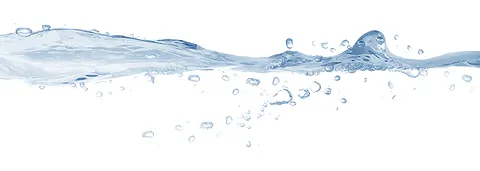
Gemstone Water - Tips on the individual stones from A to Z
The easiest way to transfer information from Gemstones to Water, and thus create Gemstone Water, is to use Water Stones. This can be done in a direct way, by placing the purified stones in a glass pitcher or jug, which is filled with fresh water and left for a few hours or overnight.
But the information transfer from stones to water also works without direct contact. To do this, the stones are placed in a small glass vessel, such as a test tube, which is then suspended in the larger vessel filled with water. This one is a bit cumbersome in everyday life, though. Therefore, the most elegant and easiest way of this method of making Gemstone Water are the closed Crystal Vital Sticks from Lapis Vitalis and the vials from VitaJuwel filled with selected stones.
Peculiarities in the selection of gemstones for gemstone water
When putting stones directly into water, there are some peculiarities in the selection of stone varieties, to which one should pay attention:
+ For the production of gemstone water, only those stones should be used that are not water-soluble and do not release any harmful substances. Best suited for this are all minerals of the quartz group, such as Amethyst, Rock Crystal, Rose Quartz and Smoky Quartz. Microcrystalline quartz such as Agate, Aventurine, Carnelian, Chalcedony, Chrysoprase, Heliotrope, Jasper, Mookaite and Sardonyx can also become problem-free.

+ Some water stones such as sodalite and black tourmaline contain traces of aluminum, but this is firmly anchored in the molecular structure of the stones. So there is no danger of it dissolving and passing into the water. Even the calcite used as a water stone is soluble only in acids. In drinking water, the solubility is so minimal that it would take centuries to completely dissolve a Calcite Water Stone.
Be careful with these gemstones when using as water stones
+ On the other hand, caution is advised with all stones that contain copper compounds. These include Azurite, Turquoise, Malachite and Chrysocoll. They are not suitable for direct insertion into water, since the resulting copper oxide is toxic.
+ Also shungite should not be put directly into the water.
If you wish to experiment with Water Stones not mentioned in here, please be sure to prefer the indirect method. You can also find a lot more information about the individual types of stones in the practical book
"Gem Water" by Michael Gienger and Joachim Goebel.

+ In addition to the type of stone, also pay attention to the external condition of water stones. Completely rough, only broken stones (so-called decoration stones) are often sharp-edged and chip easily. Polished stones, on the other hand, are often treated with wax and polishing agents to create an optimal shine. This is completely harmless for use as decorative stones, but in drinking water you want to avoid these foreign substances. Therefore, the most suitable stones for the production of gemstone water are those that have been roughly tumbled, but not yet polished. For more details on the production of gemstone water, see Gemstone Water - Production and Effect




